ENS5253: Automated Bottle Filling and Capping Control System
VerifiedAdded on 2023/01/19
|17
|2670
|51
Report
AI Summary
This report provides a comprehensive analysis of an automated bottle filling and capping control system, focusing on its implementation within a bottling factory. The report begins with an introduction to Programmable Logic Controllers (PLCs) and their application in industrial automation, emphasizing their role in monitoring input devices and controlling output devices. It then outlines the control objectives, which include developing student understanding of PLC characteristics and system control functions. The background section traces the evolution of control systems from relay-based systems to the modern PLC, highlighting the benefits of PLCs in terms of cost reduction and increased efficiency. The objective selection section details the control objectives, such as regulating speed, temperature, pressure, and flow. The system implementation section describes the bottle filling and capping process, including the use of conveyor belts, sensors, and software configuration using ROCKWELL PLC and RSLOGIX500. The report also addresses the challenges faced in automated bottle filling, such as improper timing and bottle filling levels. The conclusion summarizes the system's accuracy, precision, and ability to meet market demands, alongside the use of SCADA for monitoring. Appendices include control philosophy and algorithm logic tables. The report is a case study assignment from Edith Cowan University for the Control Systems course ENS5253.
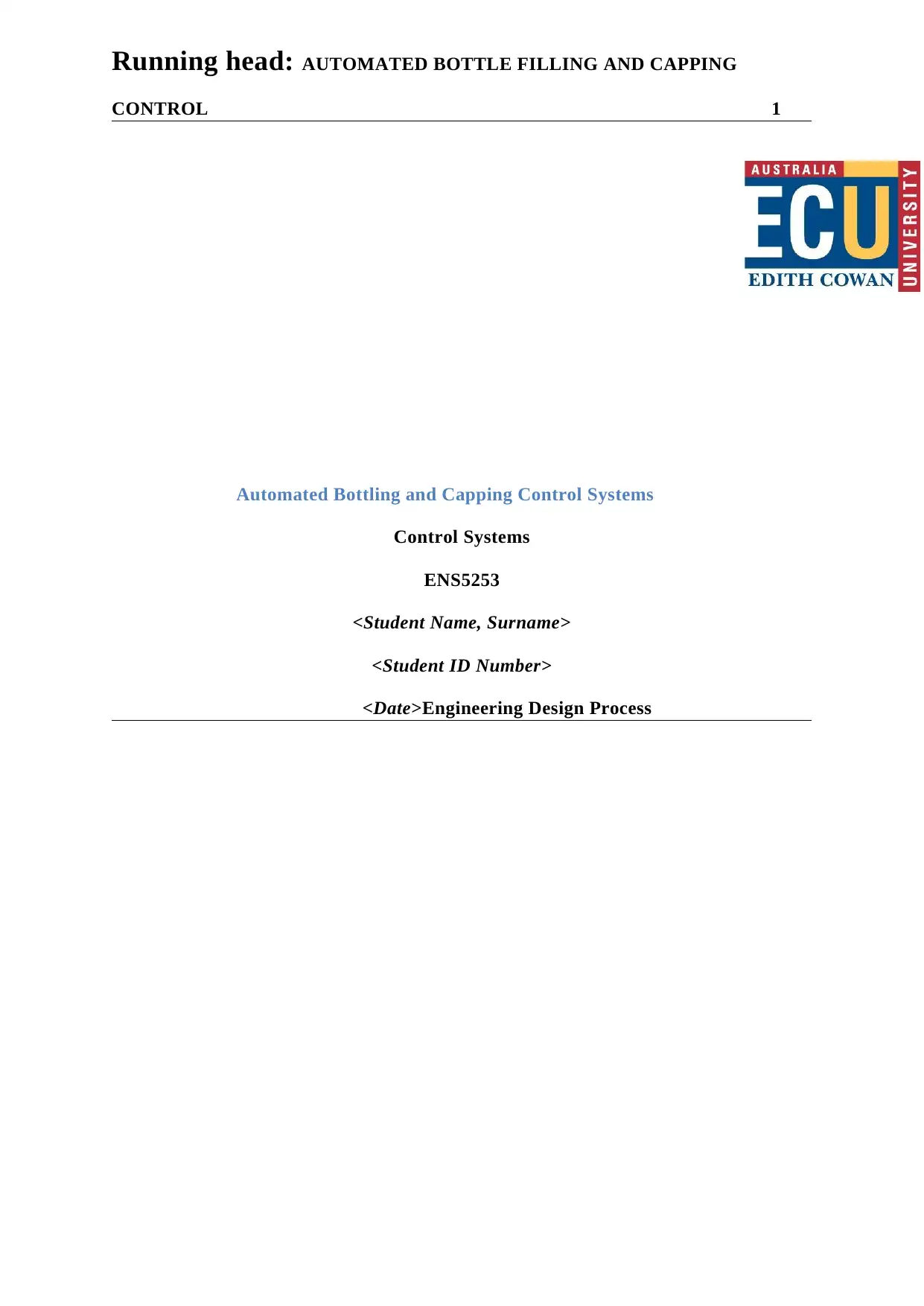
Running head: AUTOMATED BOTTLE FILLING AND CAPPING
CONTROL 1
Automated Bottling and Capping Control Systems
Control Systems
ENS5253
<Student Name, Surname>
<Student ID Number>
<Date>Engineering Design Process
CONTROL 1
Automated Bottling and Capping Control Systems
Control Systems
ENS5253
<Student Name, Surname>
<Student ID Number>
<Date>Engineering Design Process
Paraphrase This Document
Need a fresh take? Get an instant paraphrase of this document with our AI Paraphraser
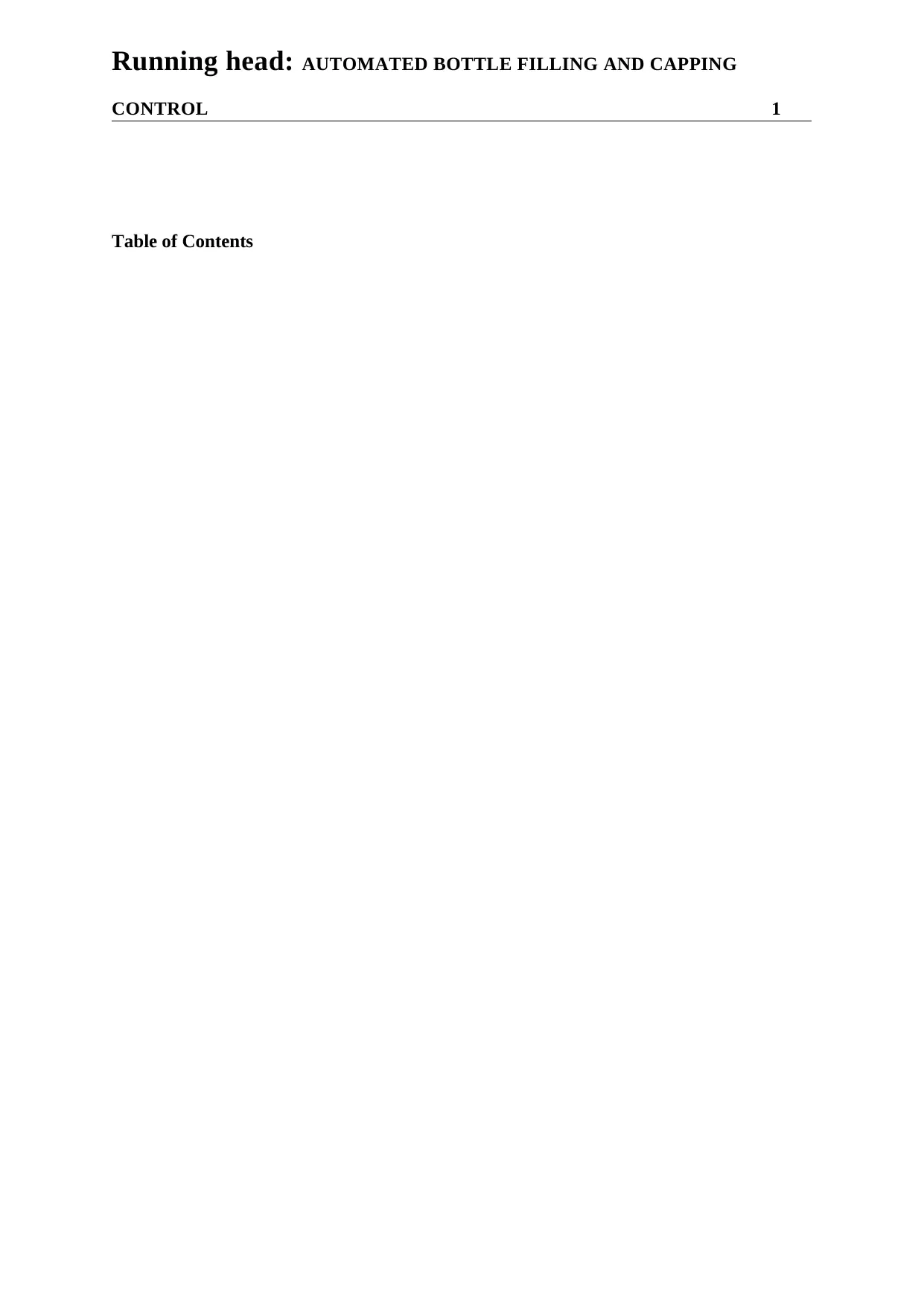
Running head: AUTOMATED BOTTLE FILLING AND CAPPING
CONTROL 1
Table of Contents
CONTROL 1
Table of Contents

AUTOMATED BOTTLING AND CAPPING CONTROL SYSTEM 3
1.0 Introduction......................................................................................................................3
1.1 Description of the Control Objectives...........................................................................3
2.0 Background.......................................................................................................................3
3.0 Objective Selection...........................................................................................................4
3.1 Control Objective............................................................................................................4
3.2 Performance of Controller..............................................................................................4
4.0 System Implementation....................................................................................................5
4.1 Bottle filing and capping.................................................................................................5
4.2 Problems Faced................................................................................................................6
In automatic bottle filling there are some problems facing this process:......................................6
4.3 Software Configuration...................................................................................................6
5 Conclusion.........................................................................................................................7
6 References..........................................................................................................................8
7 Appendices........................................................................................................................9
Table of Figures
Figure 1..........................................................................................................................................................2
17/04/19 Automated bottle filling and capping control system Control Systems ENS5253
1.0 Introduction......................................................................................................................3
1.1 Description of the Control Objectives...........................................................................3
2.0 Background.......................................................................................................................3
3.0 Objective Selection...........................................................................................................4
3.1 Control Objective............................................................................................................4
3.2 Performance of Controller..............................................................................................4
4.0 System Implementation....................................................................................................5
4.1 Bottle filing and capping.................................................................................................5
4.2 Problems Faced................................................................................................................6
In automatic bottle filling there are some problems facing this process:......................................6
4.3 Software Configuration...................................................................................................6
5 Conclusion.........................................................................................................................7
6 References..........................................................................................................................8
7 Appendices........................................................................................................................9
Table of Figures
Figure 1..........................................................................................................................................................2
17/04/19 Automated bottle filling and capping control system Control Systems ENS5253
⊘ This is a preview!⊘
Do you want full access?
Subscribe today to unlock all pages.

Trusted by 1+ million students worldwide
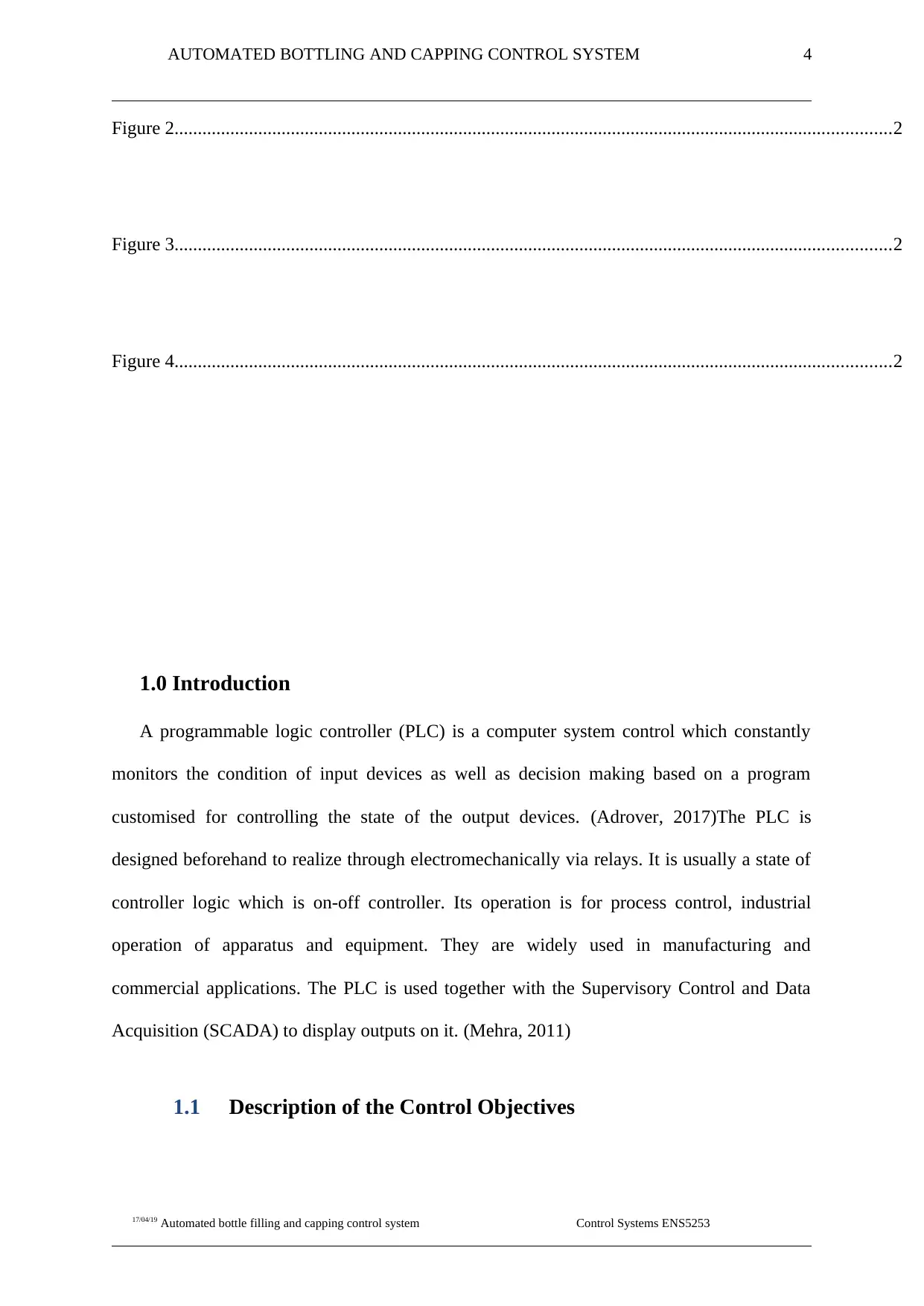
AUTOMATED BOTTLING AND CAPPING CONTROL SYSTEM 4
Figure 2..........................................................................................................................................................2
Figure 3..........................................................................................................................................................2
Figure 4..........................................................................................................................................................2
1.0 Introduction
A programmable logic controller (PLC) is a computer system control which constantly
monitors the condition of input devices as well as decision making based on a program
customised for controlling the state of the output devices. (Adrover, 2017)The PLC is
designed beforehand to realize through electromechanically via relays. It is usually a state of
controller logic which is on-off controller. Its operation is for process control, industrial
operation of apparatus and equipment. They are widely used in manufacturing and
commercial applications. The PLC is used together with the Supervisory Control and Data
Acquisition (SCADA) to display outputs on it. (Mehra, 2011)
1.1 Description of the Control Objectives
17/04/19 Automated bottle filling and capping control system Control Systems ENS5253
Figure 2..........................................................................................................................................................2
Figure 3..........................................................................................................................................................2
Figure 4..........................................................................................................................................................2
1.0 Introduction
A programmable logic controller (PLC) is a computer system control which constantly
monitors the condition of input devices as well as decision making based on a program
customised for controlling the state of the output devices. (Adrover, 2017)The PLC is
designed beforehand to realize through electromechanically via relays. It is usually a state of
controller logic which is on-off controller. Its operation is for process control, industrial
operation of apparatus and equipment. They are widely used in manufacturing and
commercial applications. The PLC is used together with the Supervisory Control and Data
Acquisition (SCADA) to display outputs on it. (Mehra, 2011)
1.1 Description of the Control Objectives
17/04/19 Automated bottle filling and capping control system Control Systems ENS5253
Paraphrase This Document
Need a fresh take? Get an instant paraphrase of this document with our AI Paraphraser

AUTOMATED BOTTLING AND CAPPING CONTROL SYSTEM 5
The main descriptive control objectives of the case study are to develop the prior
knowledge of the student about the PLC characteristics such as asynchronous and
synchronous in the bottling process. Furthermore, schematic analysis of the bottling process,
statements for safety requirements and interlocking functions, Understanding about system
control function charts , choice of the required hardware units, PLC programming, PLC
simulation and start-ups procedure. Another objective for this project is the giving of absolute
learning experience to develop practical skills for students that will make them have
knowledge of it during internship.
2.0Background
The early days before the PLC invention the machine were being controlled by the use of
relays. The relay works through the utilization of a coil which if energized which can creates
magnetism force that is able to pull the switch to OFF and ON position. (Patel, 2017)
Whenever there is de-energization of the relay, a switch releases also returns a device to its
original standards positions of ON and OFF. But due to constant energization or de-
energization the relay systems brought a problem of switching them ON and OFF in order to
control electromechanical systems. Sometimes, if there is no power for relays, the systems
never worked. (Cirrito, 2018)
The invention of the PLC has indeed brought revolution to automation in different
manufacturing sector of the economy. Before the year 1968, there were no PLCs. The main
reason of PLC design was to do away with large relay replacing cost that was involved
control of machines for U.S. car makers. The Digital Equipment Corp. DEC PDP-8, was a
widely used at that time as a mini-computer; the schemes were proposed by some companies
17/04/19 Automated bottle filling and capping control system Control Systems ENS5253
The main descriptive control objectives of the case study are to develop the prior
knowledge of the student about the PLC characteristics such as asynchronous and
synchronous in the bottling process. Furthermore, schematic analysis of the bottling process,
statements for safety requirements and interlocking functions, Understanding about system
control function charts , choice of the required hardware units, PLC programming, PLC
simulation and start-ups procedure. Another objective for this project is the giving of absolute
learning experience to develop practical skills for students that will make them have
knowledge of it during internship.
2.0Background
The early days before the PLC invention the machine were being controlled by the use of
relays. The relay works through the utilization of a coil which if energized which can creates
magnetism force that is able to pull the switch to OFF and ON position. (Patel, 2017)
Whenever there is de-energization of the relay, a switch releases also returns a device to its
original standards positions of ON and OFF. But due to constant energization or de-
energization the relay systems brought a problem of switching them ON and OFF in order to
control electromechanical systems. Sometimes, if there is no power for relays, the systems
never worked. (Cirrito, 2018)
The invention of the PLC has indeed brought revolution to automation in different
manufacturing sector of the economy. Before the year 1968, there were no PLCs. The main
reason of PLC design was to do away with large relay replacing cost that was involved
control of machines for U.S. car makers. The Digital Equipment Corp. DEC PDP-8, was a
widely used at that time as a mini-computer; the schemes were proposed by some companies
17/04/19 Automated bottle filling and capping control system Control Systems ENS5253

AUTOMATED BOTTLING AND CAPPING CONTROL SYSTEM 6
for automation by the use of the mini-computers. The Bedford Associates proposed about
MODICON (Modular Digital Controller).Their MODICON 084, was the first PLC for
commercial production.
Since 1968, there has been a steady increase slowly of applications of the PLCs in
manufacturing and processing section of industrial controls. It is Morley of Bedford
Associates invented the PLC, but many technocrats have made contribution on improving its
operations.
The General Electrical made attempts to standardize the interlinking of multiple
components from different manufacturers. Then the PLC software program than can run on
person computer was developed to eliminated dedication for programming terminal needs.
By the 1990s less communication protocols as well as latest standards attempted to combine
the PLC languages of programming for international standards. The PLCs have been
developed for year to include control process, motion control, complex networking and
control of distributed systems. The capacity of PLCs for handling data storage, power
processing also communication success is equivalent to desktop computer.
Since the PLC products have been easily available for automation use in various
industries which need controls to their systems. The PLCs have reduced the labour costs and
increased the efficient for mass production.
This automation process is used system control of filling and capping of the bottles same
time in a bottling factory to decrease human operation effort through PLC and Supervisory
Control and Data Acquisition (SCADA).The SCADA acts as the display unit after the
program is animated. (Wu, 2011)
17/04/19 Automated bottle filling and capping control system Control Systems ENS5253
for automation by the use of the mini-computers. The Bedford Associates proposed about
MODICON (Modular Digital Controller).Their MODICON 084, was the first PLC for
commercial production.
Since 1968, there has been a steady increase slowly of applications of the PLCs in
manufacturing and processing section of industrial controls. It is Morley of Bedford
Associates invented the PLC, but many technocrats have made contribution on improving its
operations.
The General Electrical made attempts to standardize the interlinking of multiple
components from different manufacturers. Then the PLC software program than can run on
person computer was developed to eliminated dedication for programming terminal needs.
By the 1990s less communication protocols as well as latest standards attempted to combine
the PLC languages of programming for international standards. The PLCs have been
developed for year to include control process, motion control, complex networking and
control of distributed systems. The capacity of PLCs for handling data storage, power
processing also communication success is equivalent to desktop computer.
Since the PLC products have been easily available for automation use in various
industries which need controls to their systems. The PLCs have reduced the labour costs and
increased the efficient for mass production.
This automation process is used system control of filling and capping of the bottles same
time in a bottling factory to decrease human operation effort through PLC and Supervisory
Control and Data Acquisition (SCADA).The SCADA acts as the display unit after the
program is animated. (Wu, 2011)
17/04/19 Automated bottle filling and capping control system Control Systems ENS5253
⊘ This is a preview!⊘
Do you want full access?
Subscribe today to unlock all pages.

Trusted by 1+ million students worldwide
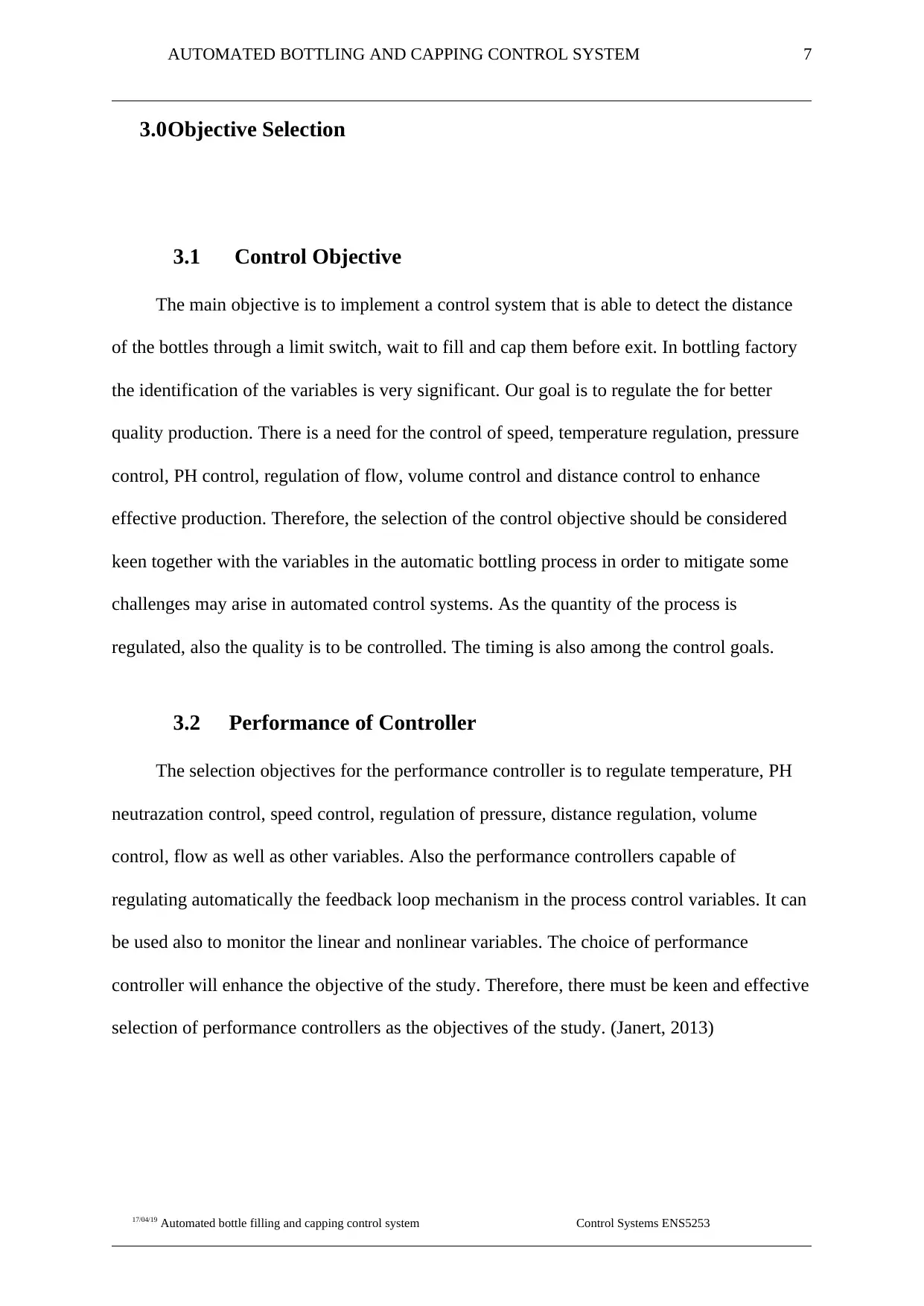
AUTOMATED BOTTLING AND CAPPING CONTROL SYSTEM 7
3.0Objective Selection
3.1 Control Objective
The main objective is to implement a control system that is able to detect the distance
of the bottles through a limit switch, wait to fill and cap them before exit. In bottling factory
the identification of the variables is very significant. Our goal is to regulate the for better
quality production. There is a need for the control of speed, temperature regulation, pressure
control, PH control, regulation of flow, volume control and distance control to enhance
effective production. Therefore, the selection of the control objective should be considered
keen together with the variables in the automatic bottling process in order to mitigate some
challenges may arise in automated control systems. As the quantity of the process is
regulated, also the quality is to be controlled. The timing is also among the control goals.
3.2 Performance of Controller
The selection objectives for the performance controller is to regulate temperature, PH
neutrazation control, speed control, regulation of pressure, distance regulation, volume
control, flow as well as other variables. Also the performance controllers capable of
regulating automatically the feedback loop mechanism in the process control variables. It can
be used also to monitor the linear and nonlinear variables. The choice of performance
controller will enhance the objective of the study. Therefore, there must be keen and effective
selection of performance controllers as the objectives of the study. (Janert, 2013)
17/04/19 Automated bottle filling and capping control system Control Systems ENS5253
3.0Objective Selection
3.1 Control Objective
The main objective is to implement a control system that is able to detect the distance
of the bottles through a limit switch, wait to fill and cap them before exit. In bottling factory
the identification of the variables is very significant. Our goal is to regulate the for better
quality production. There is a need for the control of speed, temperature regulation, pressure
control, PH control, regulation of flow, volume control and distance control to enhance
effective production. Therefore, the selection of the control objective should be considered
keen together with the variables in the automatic bottling process in order to mitigate some
challenges may arise in automated control systems. As the quantity of the process is
regulated, also the quality is to be controlled. The timing is also among the control goals.
3.2 Performance of Controller
The selection objectives for the performance controller is to regulate temperature, PH
neutrazation control, speed control, regulation of pressure, distance regulation, volume
control, flow as well as other variables. Also the performance controllers capable of
regulating automatically the feedback loop mechanism in the process control variables. It can
be used also to monitor the linear and nonlinear variables. The choice of performance
controller will enhance the objective of the study. Therefore, there must be keen and effective
selection of performance controllers as the objectives of the study. (Janert, 2013)
17/04/19 Automated bottle filling and capping control system Control Systems ENS5253
Paraphrase This Document
Need a fresh take? Get an instant paraphrase of this document with our AI Paraphraser
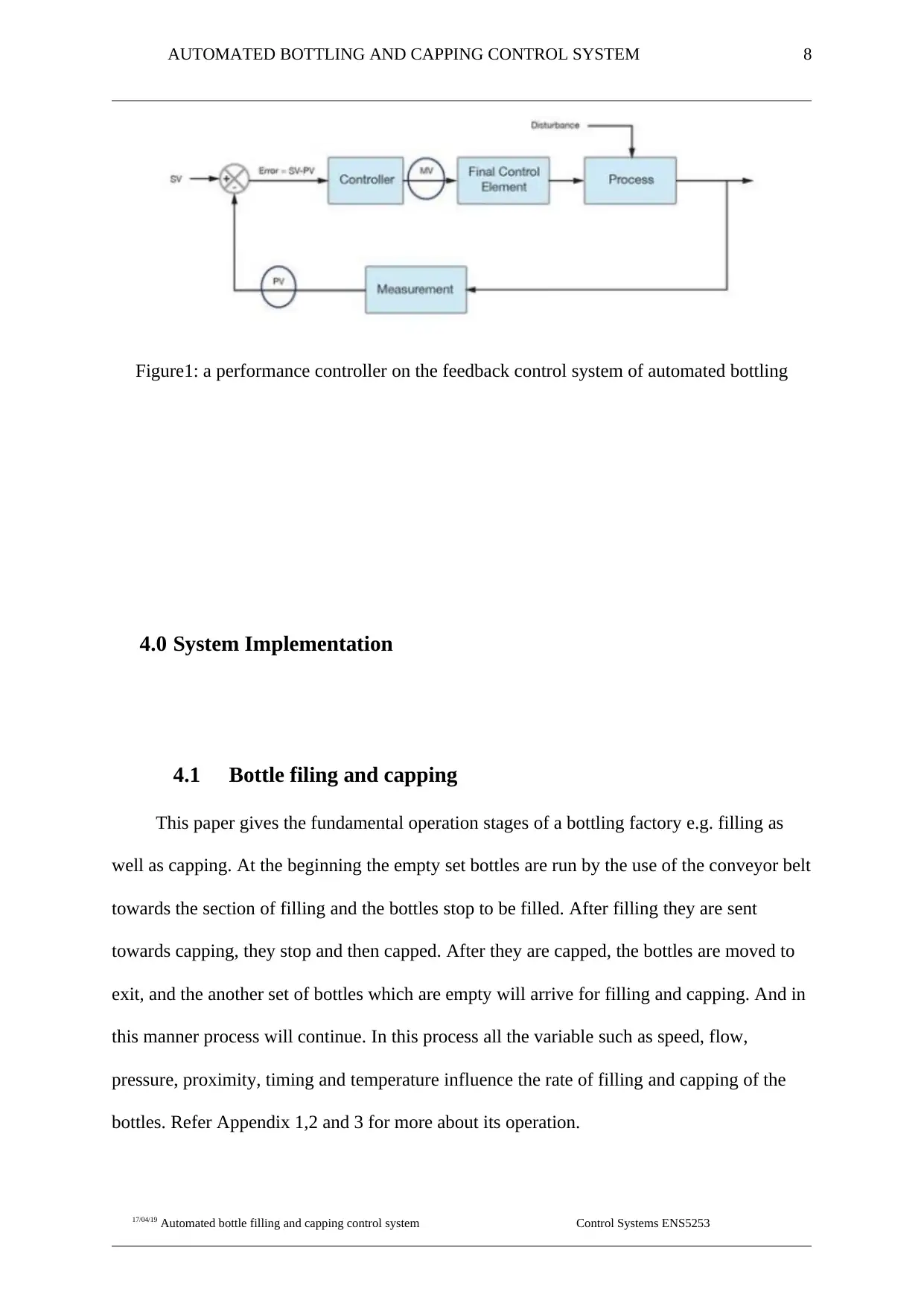
AUTOMATED BOTTLING AND CAPPING CONTROL SYSTEM 8
Figure1: a performance controller on the feedback control system of automated bottling
4.0 System Implementation
4.1 Bottle filing and capping
This paper gives the fundamental operation stages of a bottling factory e.g. filling as
well as capping. At the beginning the empty set bottles are run by the use of the conveyor belt
towards the section of filling and the bottles stop to be filled. After filling they are sent
towards capping, they stop and then capped. After they are capped, the bottles are moved to
exit, and the another set of bottles which are empty will arrive for filling and capping. And in
this manner process will continue. In this process all the variable such as speed, flow,
pressure, proximity, timing and temperature influence the rate of filling and capping of the
bottles. Refer Appendix 1,2 and 3 for more about its operation.
17/04/19 Automated bottle filling and capping control system Control Systems ENS5253
Figure1: a performance controller on the feedback control system of automated bottling
4.0 System Implementation
4.1 Bottle filing and capping
This paper gives the fundamental operation stages of a bottling factory e.g. filling as
well as capping. At the beginning the empty set bottles are run by the use of the conveyor belt
towards the section of filling and the bottles stop to be filled. After filling they are sent
towards capping, they stop and then capped. After they are capped, the bottles are moved to
exit, and the another set of bottles which are empty will arrive for filling and capping. And in
this manner process will continue. In this process all the variable such as speed, flow,
pressure, proximity, timing and temperature influence the rate of filling and capping of the
bottles. Refer Appendix 1,2 and 3 for more about its operation.
17/04/19 Automated bottle filling and capping control system Control Systems ENS5253
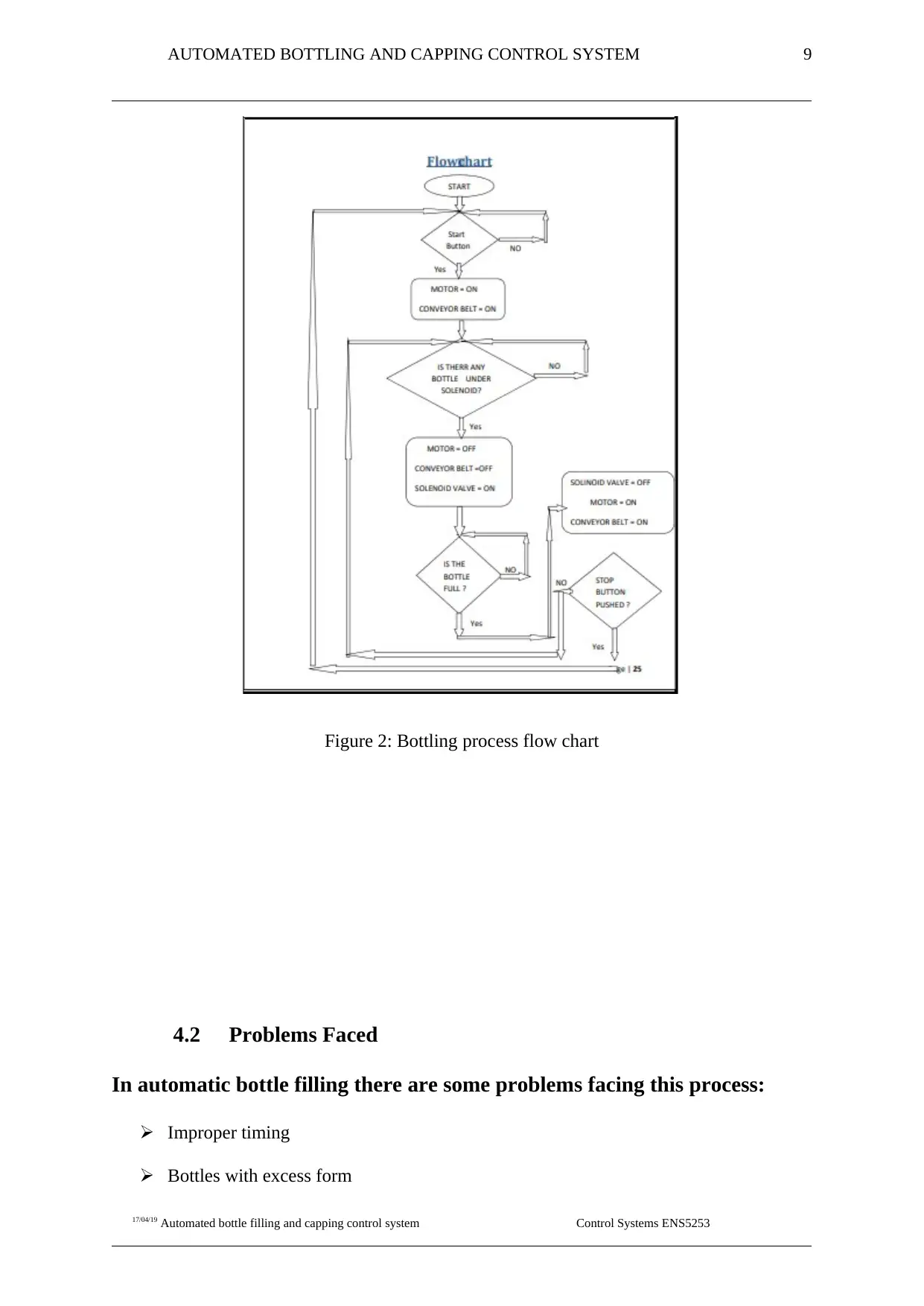
AUTOMATED BOTTLING AND CAPPING CONTROL SYSTEM 9
Figure 2: Bottling process flow chart
4.2 Problems Faced
In automatic bottle filling there are some problems facing this process:
Improper timing
Bottles with excess form
17/04/19 Automated bottle filling and capping control system Control Systems ENS5253
Figure 2: Bottling process flow chart
4.2 Problems Faced
In automatic bottle filling there are some problems facing this process:
Improper timing
Bottles with excess form
17/04/19 Automated bottle filling and capping control system Control Systems ENS5253
⊘ This is a preview!⊘
Do you want full access?
Subscribe today to unlock all pages.

Trusted by 1+ million students worldwide
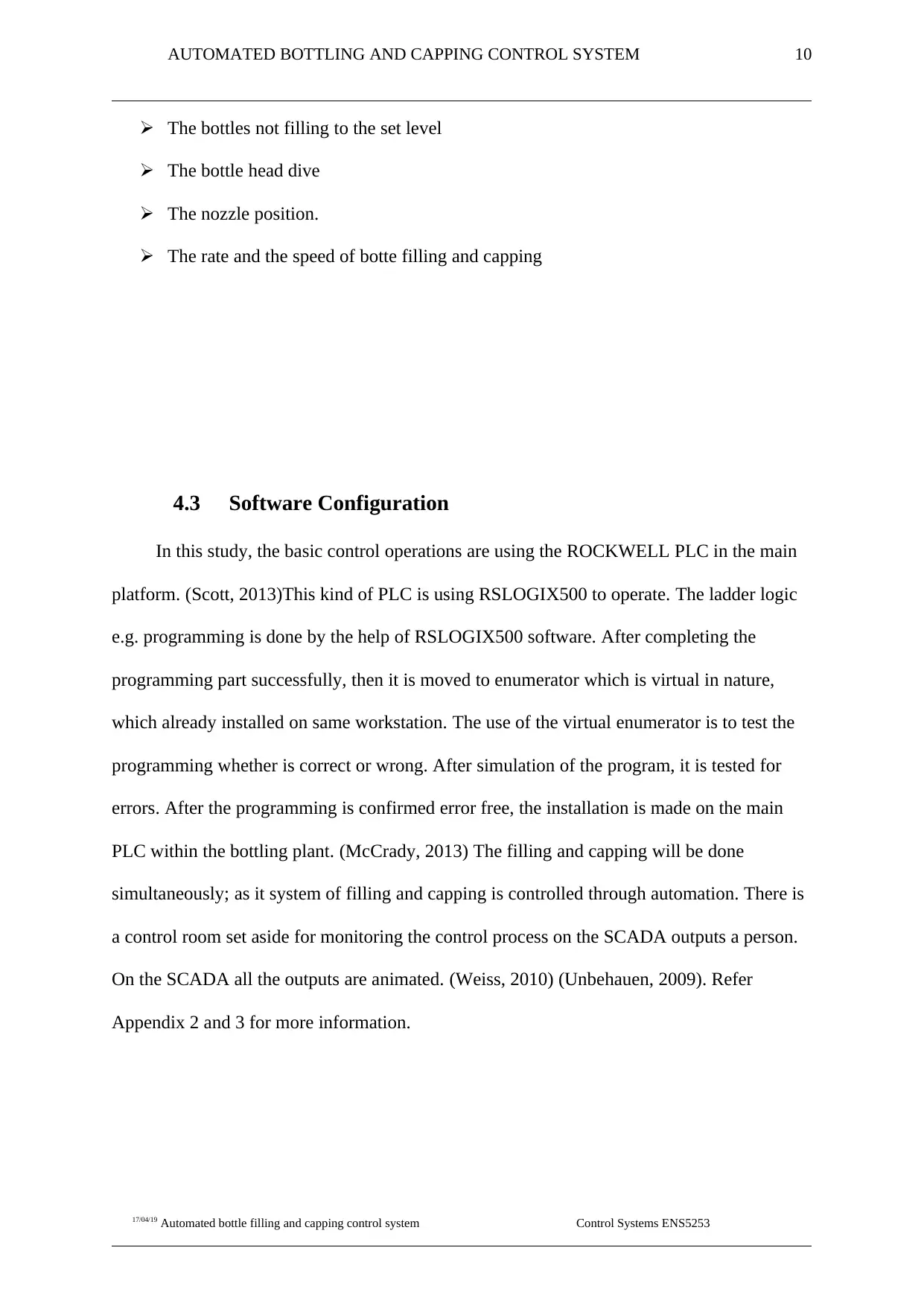
AUTOMATED BOTTLING AND CAPPING CONTROL SYSTEM 10
The bottles not filling to the set level
The bottle head dive
The nozzle position.
The rate and the speed of botte filling and capping
4.3 Software Configuration
In this study, the basic control operations are using the ROCKWELL PLC in the main
platform. (Scott, 2013)This kind of PLC is using RSLOGIX500 to operate. The ladder logic
e.g. programming is done by the help of RSLOGIX500 software. After completing the
programming part successfully, then it is moved to enumerator which is virtual in nature,
which already installed on same workstation. The use of the virtual enumerator is to test the
programming whether is correct or wrong. After simulation of the program, it is tested for
errors. After the programming is confirmed error free, the installation is made on the main
PLC within the bottling plant. (McCrady, 2013) The filling and capping will be done
simultaneously; as it system of filling and capping is controlled through automation. There is
a control room set aside for monitoring the control process on the SCADA outputs a person.
On the SCADA all the outputs are animated. (Weiss, 2010) (Unbehauen, 2009). Refer
Appendix 2 and 3 for more information.
17/04/19 Automated bottle filling and capping control system Control Systems ENS5253
The bottles not filling to the set level
The bottle head dive
The nozzle position.
The rate and the speed of botte filling and capping
4.3 Software Configuration
In this study, the basic control operations are using the ROCKWELL PLC in the main
platform. (Scott, 2013)This kind of PLC is using RSLOGIX500 to operate. The ladder logic
e.g. programming is done by the help of RSLOGIX500 software. After completing the
programming part successfully, then it is moved to enumerator which is virtual in nature,
which already installed on same workstation. The use of the virtual enumerator is to test the
programming whether is correct or wrong. After simulation of the program, it is tested for
errors. After the programming is confirmed error free, the installation is made on the main
PLC within the bottling plant. (McCrady, 2013) The filling and capping will be done
simultaneously; as it system of filling and capping is controlled through automation. There is
a control room set aside for monitoring the control process on the SCADA outputs a person.
On the SCADA all the outputs are animated. (Weiss, 2010) (Unbehauen, 2009). Refer
Appendix 2 and 3 for more information.
17/04/19 Automated bottle filling and capping control system Control Systems ENS5253
Paraphrase This Document
Need a fresh take? Get an instant paraphrase of this document with our AI Paraphraser
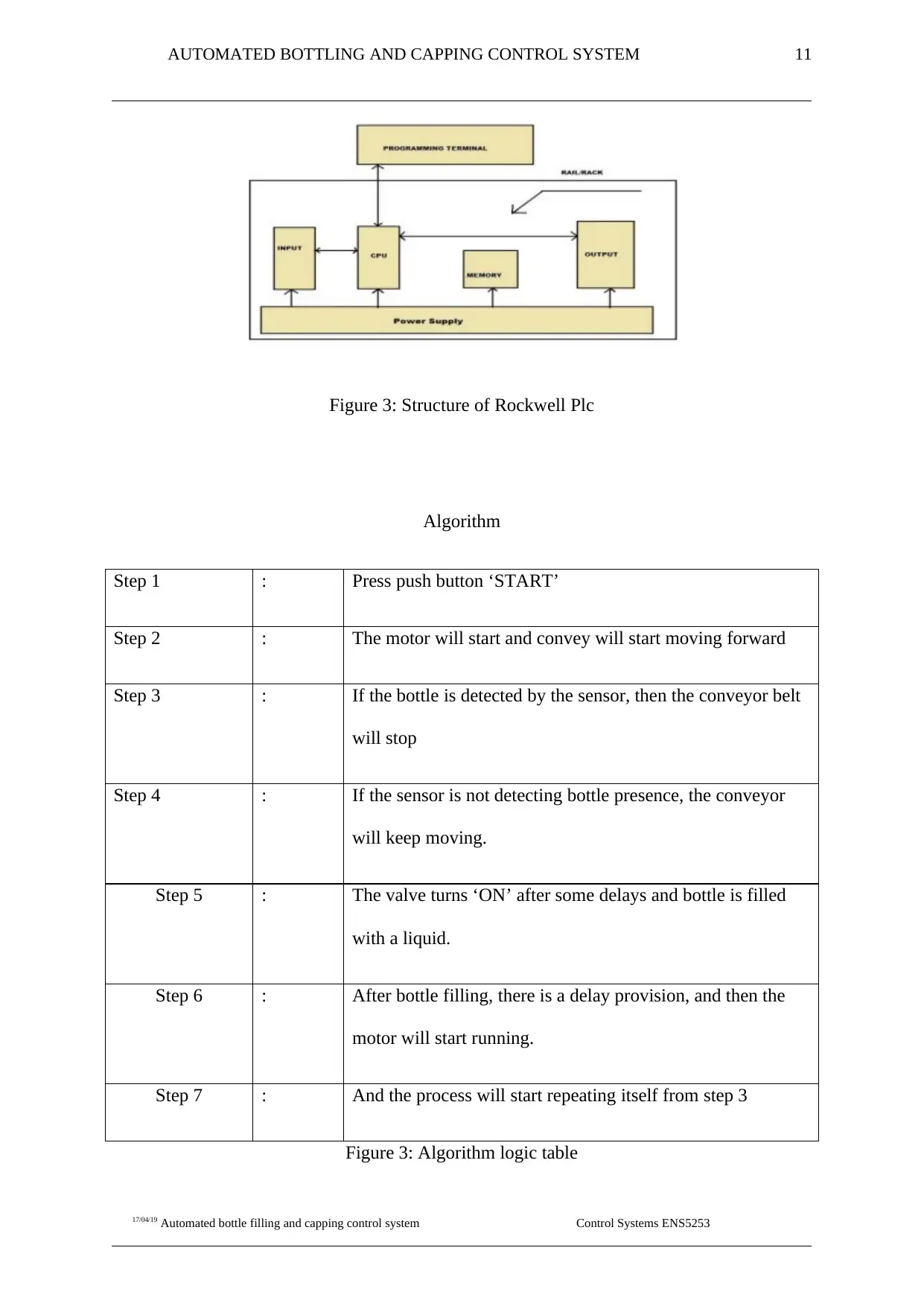
AUTOMATED BOTTLING AND CAPPING CONTROL SYSTEM 11
Figure 3: Structure of Rockwell Plc
Algorithm
Step 1 : Press push button ‘START’
Step 2 : The motor will start and convey will start moving forward
Step 3 : If the bottle is detected by the sensor, then the conveyor belt
will stop
Step 4 : If the sensor is not detecting bottle presence, the conveyor
will keep moving.
Step 5 : The valve turns ‘ON’ after some delays and bottle is filled
with a liquid.
Step 6 : After bottle filling, there is a delay provision, and then the
motor will start running.
Step 7 : And the process will start repeating itself from step 3
Figure 3: Algorithm logic table
17/04/19 Automated bottle filling and capping control system Control Systems ENS5253
Figure 3: Structure of Rockwell Plc
Algorithm
Step 1 : Press push button ‘START’
Step 2 : The motor will start and convey will start moving forward
Step 3 : If the bottle is detected by the sensor, then the conveyor belt
will stop
Step 4 : If the sensor is not detecting bottle presence, the conveyor
will keep moving.
Step 5 : The valve turns ‘ON’ after some delays and bottle is filled
with a liquid.
Step 6 : After bottle filling, there is a delay provision, and then the
motor will start running.
Step 7 : And the process will start repeating itself from step 3
Figure 3: Algorithm logic table
17/04/19 Automated bottle filling and capping control system Control Systems ENS5253
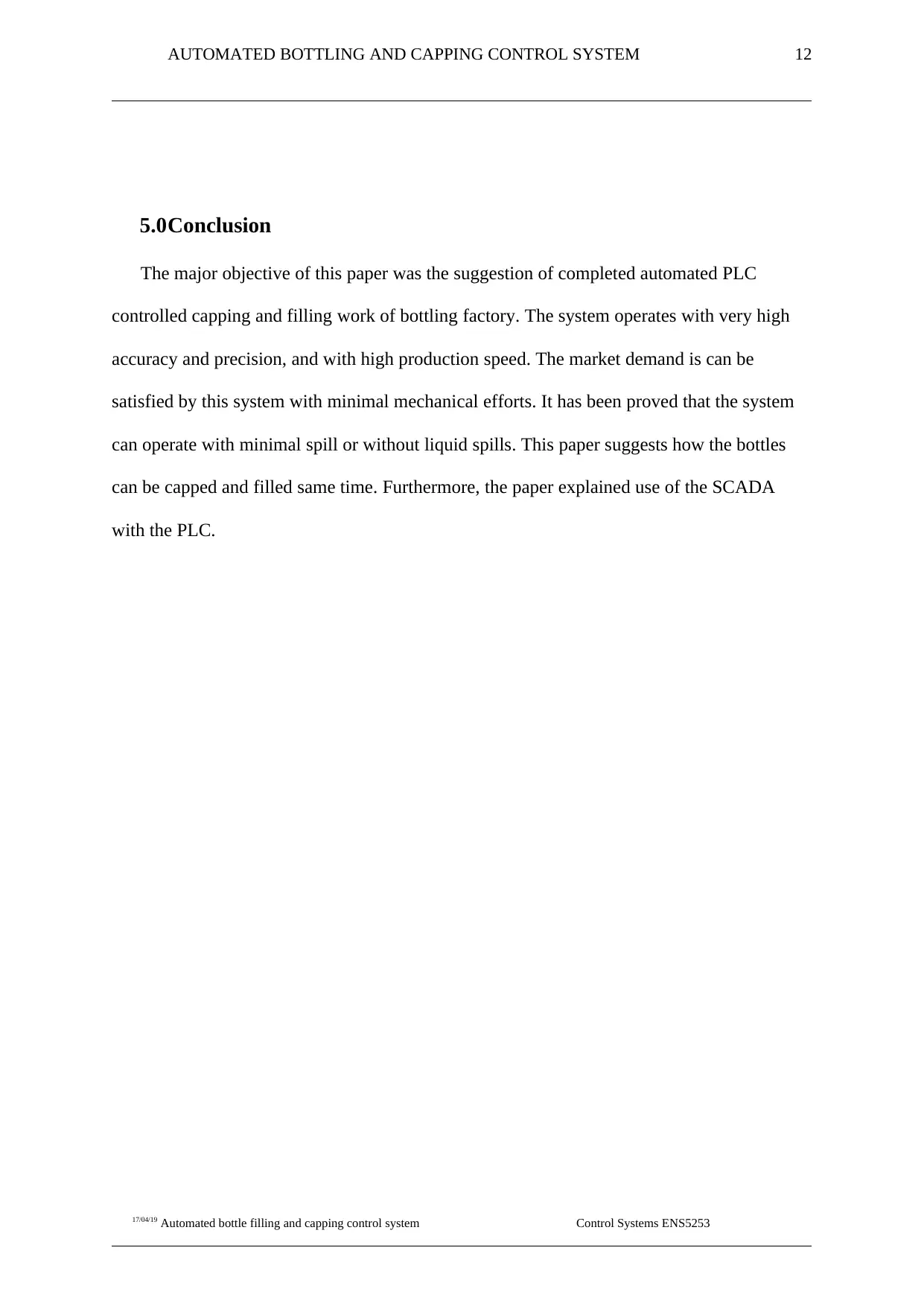
AUTOMATED BOTTLING AND CAPPING CONTROL SYSTEM 12
5.0Conclusion
The major objective of this paper was the suggestion of completed automated PLC
controlled capping and filling work of bottling factory. The system operates with very high
accuracy and precision, and with high production speed. The market demand is can be
satisfied by this system with minimal mechanical efforts. It has been proved that the system
can operate with minimal spill or without liquid spills. This paper suggests how the bottles
can be capped and filled same time. Furthermore, the paper explained use of the SCADA
with the PLC.
17/04/19 Automated bottle filling and capping control system Control Systems ENS5253
5.0Conclusion
The major objective of this paper was the suggestion of completed automated PLC
controlled capping and filling work of bottling factory. The system operates with very high
accuracy and precision, and with high production speed. The market demand is can be
satisfied by this system with minimal mechanical efforts. It has been proved that the system
can operate with minimal spill or without liquid spills. This paper suggests how the bottles
can be capped and filled same time. Furthermore, the paper explained use of the SCADA
with the PLC.
17/04/19 Automated bottle filling and capping control system Control Systems ENS5253
⊘ This is a preview!⊘
Do you want full access?
Subscribe today to unlock all pages.

Trusted by 1+ million students worldwide
1 out of 17
Your All-in-One AI-Powered Toolkit for Academic Success.
+13062052269
info@desklib.com
Available 24*7 on WhatsApp / Email
![[object Object]](/_next/static/media/star-bottom.7253800d.svg)
Unlock your academic potential
Copyright © 2020–2025 A2Z Services. All Rights Reserved. Developed and managed by ZUCOL.


